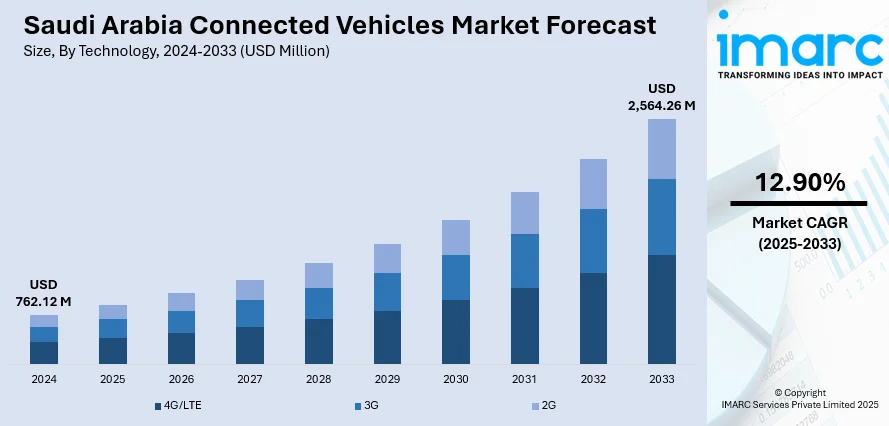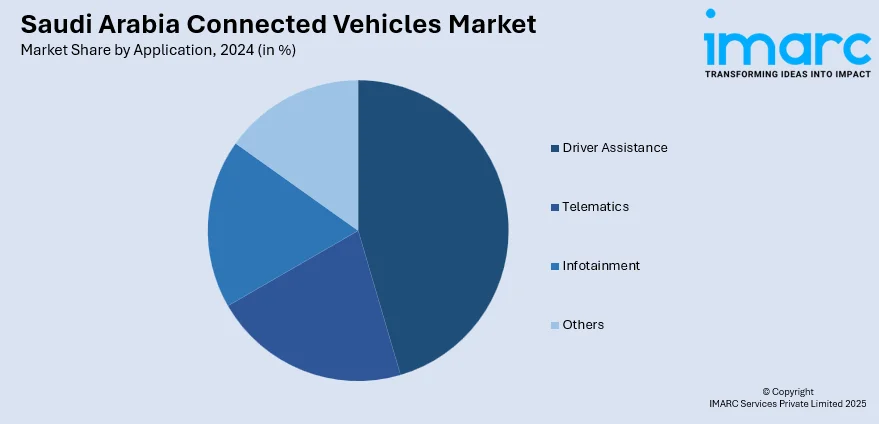
Saudi Arabia Connected Vehicles Market Size, Share, Trends and Forecast by Technology, Application, Connectivity, Vehicle Connectivity, Vehicle, and Region, 2025-2033
Saudi Arabia Connected Vehicles Market Overview:
The Saudi Arabia connected vehicles market size reached USD 762.12 Million in 2024. Looking forward, IMARC Group expects the market to reach USD 2,564.26 Million by 2033, exhibiting a growth rate (CAGR) of 12.90% during 2025-2033. The market is advancing through government-led smart mobility initiatives, widespread 5G deployment, and consumer demand for advanced safety features. The development of smart cities like NEOM and the integration of AI and IoT technologies are transforming transportation infrastructure. Collaborations between automakers and tech firms further drive innovation, shaping the competitive landscape of the Saudi Arabia connected vehicles market share.
|
Report Attribute
|
Key Statistics
|
|---|---|
|
Base Year
|
2024 |
|
Forecast Years
|
2025-2033
|
|
Historical Years
|
2019-2024
|
| Market Size in 2024 | USD 762.12 Million |
| Market Forecast in 2033 | USD 2,564.26 Million |
| Market Growth Rate 2025-2033 | 12.90% |
Saudi Arabia Connected Vehicles Market Trends:
Vision 2030 and Smart City Development
Saudi Arabia's Vision 2030 initiative is a cornerstone in transforming the nation's transportation landscape. By supporting diverse industries and new technologies, the government is focusing major efforts on projects like NEOM and The Line. This means using upcoming technologies, such as linked and self-driving cars, as part of their transport system. Sustainable and intelligent transportation fits into the wider aims of cutting back on carbon emissions and improving city living conditions. This leads global automotive and tech companies to choose Saudi Arabia and promotes the expansion of connected cars, making it a leader in innovative transportation solutions.

Technological Innovation and Global Partnerships
Saudi Arabia is actively fostering collaborations between domestic entities and international automotive and technology firms to drive innovation in connected vehicle technologies. Partnerships with companies like Tesla, BYD, and Lucid Motors are instrumental in introducing advanced electric and autonomous vehicles to the Saudi market. These alliances facilitate the transfer of knowledge and technology, enabling the development of localized solutions tailored to the Kingdom's unique needs. Moreover, investments in research and development, as well as the establishment of manufacturing facilities, are creating a robust ecosystem that supports the Saudi Arabia connected vehicles market growth. Such strategic collaborations are pivotal in positioning Saudi Arabia as a hub for automotive innovation.
Consumer Demand for Safety and Infotainment Features
The Saudi consumer market is increasingly favoring vehicles equipped with advanced safety and infotainment features. Modern drivers seek technologies like lane-keeping assist, adaptive cruise control, and real-time traffic updates to enhance safety and convenience. Simultaneously, the demand for in-car entertainment systems that offer seamless smartphone integration, voice commands, and streaming services is on the rise. Automakers are responding by incorporating these features into a broader range of vehicle models, making them more accessible to the average consumer. This shift in consumer preferences is a significant catalyst for the expansion of the connected vehicles market in Saudi Arabia, as manufacturers strive to meet the growing demand for integrated, technology-driven driving experiences.
Saudi Arabia Connected Vehicles Market Segmentation:
IMARC Group provides an analysis of the key trends in each segment of the market, along with forecasts at the country and regional levels for 2025-2033. Our report has categorized the market based on technology, application, connectivity, vehicle connectivity, and vehicle.
Technology Insights:
- 4G/LTE
- 3G
- 2G
The report has provided a detailed breakup and analysis of the market based on the technology. This includes 4G/LTE, 3G, and 2G.
Application Insights:

- Driver Assistance
- Telematics
- Infotainment
- Others
A detailed breakup and analysis of the market based on the application have also been provided in the report. This includes driver assistance, telematics, infotainment, and others.
Connectivity Insights:
- Integrated
- Embedded
- Tethered
A detailed breakup and analysis of the market based on connectivity have also been provided in the report. This includes integrated, embedded, and tethered.
Vehicle Connectivity Insights:
- Vehicle to Vehicle (V2V)
- Vehicle to Infrastructure (V2I)
- Vehicle to Pedestrian (V2P)
A detailed breakup and analysis of the market based on vehicle connectivity have also been provided in the report. This includes Vehicle to Vehicle (V2V), Vehicle to Infrastructure (V2I), and Vehicle to Pedestrian (V2P).
Vehicle Insights:
- Passenger Cars
- Commercial Vehicles
A detailed breakup and analysis of the market based on the vehicle have also been provided in the report. This includes passenger cars and commercial vehicles.
Regional Insights:
- Northern and Central Region
- Western Region
- Eastern Region
- Southern Region
The report has also provided a comprehensive analysis of all the major regional markets, which include the Northern and Central Region, Western Region, Eastern Region, and Southern Region.
Competitive Landscape:
The market research report has also provided a comprehensive analysis of the competitive landscape. Competitive analysis such as market structure, key player positioning, top winning strategies, competitive dashboard, and company evaluation quadrant has been covered in the report. Also, detailed profiles of all major companies have been provided.
Saudi Arabia Connected Vehicles Market Report Coverage:
| Report Features | Details |
|---|---|
| Base Year of the Analysis | 2024 |
| Historical Period | 2019-2024 |
| Forecast Period | 2025-2033 |
| Units | Million USD |
| Scope of the Report |
Exploration of Historical Trends and Market Outlook, Industry Catalysts and Challenges, Segment-Wise Historical and Future Market Assessment:
|
| Technologies Covered | 4G/LTE, 3G, 2G |
| Applications Covered | Driver Assistance, Telematics, Infotainment, Others |
| Connectivity Covered | Integrated, Embedded, Tethered |
| Vehicle Connectivities Covered | Vehicle to Vehicle (V2V), Vehicle to Infrastructure (V2I), Vehicle to Pedestrian (V2P) |
| Vehicles Covered | Passenger Cars, Commercial Vehicles |
| Regions Covered | Northern and Central Region, Western Region, Eastern Region, Southern Region |
| Customization Scope | 10% Free Customization |
| Post-Sale Analyst Support | 10-12 Weeks |
| Delivery Format | PDF and Excel through Email (We can also provide the editable version of the report in PPT/Word format on special request) |
Key Questions Answered in This Report:
- How has the Saudi Arabia connected vehicles market performed so far and how will it perform in the coming years?
- What is the breakup of the Saudi Arabia connected vehicles market on the basis of technology?
- What is the breakup of the Saudi Arabia connected vehicles market on the basis of application?
- What is the breakup of the Saudi Arabia connected vehicles market on the basis of connectivity?
- What is the breakup of the Saudi Arabia connected vehicles market on the basis of vehicle connectivity?
- What is the breakup of the Saudi Arabia connected vehicles market on the basis of vehicle?
- What is the breakup of the Saudi Arabia connected vehicles market on the basis of region?
- What are the various stages in the value chain of the Saudi Arabia connected vehicles market?
- What are the key driving factors and challenges in the Saudi Arabia connected vehicles market?
- What is the structure of the Saudi Arabia connected vehicles market and who are the key players?
- What is the degree of competition in the Saudi Arabia connected vehicles market?
Key Benefits for Stakeholders:
- IMARC’s industry report offers a comprehensive quantitative analysis of various market segments, historical and current market trends, market forecasts, and dynamics of the Saudi Arabia connected vehicles market from 2019-2033.
- The research report provides the latest information on the market drivers, challenges, and opportunities in the Saudi Arabia connected vehicles market.
- Porter's five forces analysis assist stakeholders in assessing the impact of new entrants, competitive rivalry, supplier power, buyer power, and the threat of substitution. It helps stakeholders to analyze the level of competition within the Saudi Arabia connected vehicles industry and its attractiveness.
- Competitive landscape allows stakeholders to understand their competitive environment and provides an insight into the current positions of key players in the market.
Need more help?
- Speak to our experienced analysts for insights on the current market scenarios.
- Include additional segments and countries to customize the report as per your requirement.
- Gain an unparalleled competitive advantage in your domain by understanding how to utilize the report and positively impacting your operations and revenue.
- For further assistance, please connect with our analysts.
 Request Customization
Request Customization
 Speak to an Analyst
Speak to an Analyst
 Request Brochure
Request Brochure
 Inquire Before Buying
Inquire Before Buying




.webp)




.webp)












